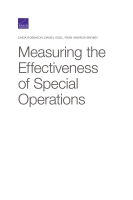by Linda Robinson, Daniel Egel, Ryan Andrew Brown
How can the success (or failure) of Army special operations missions be assessed? The authors develop a methodology for doing so that relies on operational, intelligence, and ambient (publicly available) data, since operational level special operations commands often lack robust staff and resources to generate assessment-specific information. The method assesses the plan's lines of effort and their objectives, develops relevant measures of effectiveness and indicators, and gathers appropriate qualitative and quantitative data. The resulting analysis is presented to the appropriate commander, who can then use the information to adjust lines of effort or activities and other elements. The seven-step process is illustrated through a fictional scenario. Implementation will include incorporating the approach into doctrine and training and standing up an assessment cell. The cell requires access to data streams and appropriate analytic platforms and reachback support.
Key Findings
Conducting assessments can be challenging for smaller deployed headquarters
Conducting rigorous and timely assessments is a particular challenge for smaller deployed headquarters with smaller staffs and budgets.
Collecting data and staffing the assessment process consume scarce resources and manpower.
The methodology developed leverages existing operational and intelligence reporting and publicly available data for assessments.
Recommendation
Implementing the special operations forces operational assessment approach recommended in this report will require adaptations in organization, training, materiel, leadership development and education, and personnel.

No comments:
Post a Comment